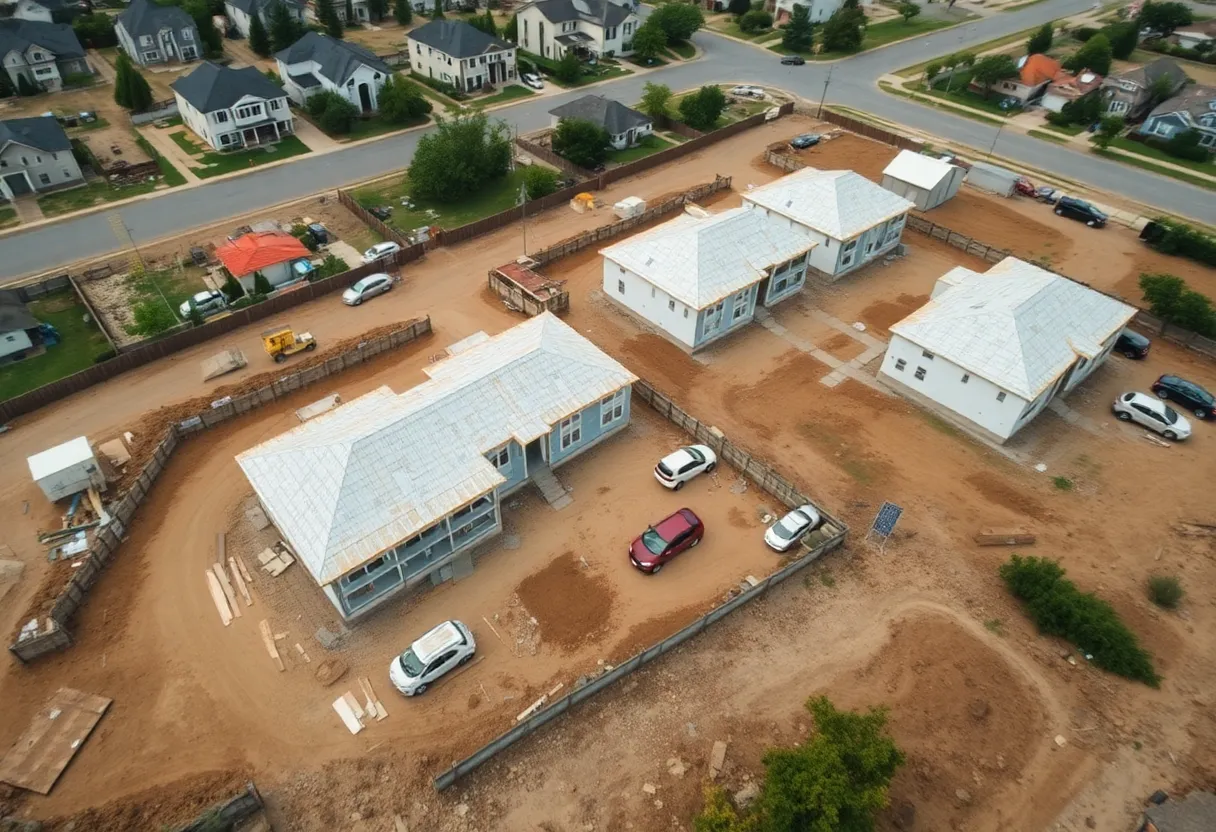News Summary
Single-family homebuilding in the U.S. has fallen to its lowest level in 11 months due to high mortgage rates and economic uncertainty. Housing starts decreased by 4.6%, leading to a total of 883,000 units, amid a decline in permits and builder sentiment. While multi-family housing is on the rise, challenges persist in the single-family sector, with an anticipated 11% drop in constructions this year and increasing completion times reflecting a slowdown in demand.
U.S. Single-Family Homebuilding Declines to 11-Month Low Amid Economic Challenges
In June 2025, U.S. single-family homebuilding experienced a significant decline, hitting an 11-month low. This downturn can be attributed to elevated mortgage rates and ongoing economic uncertainty, which have combined to hinder home purchases across the country.
The Commerce Department’s latest report showed a contraction in residential investment during the second quarter, as builders struggle to navigate the challenging economic landscape. In June, the number of permits issued for future construction also fell to its lowest level in over two years, signaling a cautious approach from builders.
Decline in Housing Starts
Data indicates that single-family housing starts decreased by 4.6%, achieving an annual rate of 883,000 units—marking the lowest level since July 2024. This decline was observed across all four U.S. regions, with particularly notable reductions in the West and South. At the same time, future building permits fell by 3.7%, dropping to a rate of 866,000 units.
Despite the overall gloomy situation for single-family homes, there was a slight uptick in permits in the Northeast, although this region represents a small fraction of the national market. Meanwhile, the average rate on a 30-year fixed mortgage has remained just below 7% this year, further complicating affordability for potential homebuyers.
Concerns Over Economic Impact
The housing sector, while a relatively small part of the gross domestic product, has an essential role due to its ripple effect on related markets such as furniture and appliances. Analysts are expressing concern that the persistent weakness in the housing market could negatively influence the broader economy, reinforcing the need for lower borrowing costs.
Barriers such as inflationary tariffs and labor shortages caused by immigration policies have been challenging for builders. As a result, many are delaying or even canceling projects, heightening worries about the future of the housing market.
Shifts in Building Trends
In an unusual trend, building projects with five or more units have reported a significant 30.6% increase, totaling 414,000 units in June. Overall housing starts increased by 4.6% to reach an annual rate of 1.321 million units, surpassing economists’ forecasts of 1.3 million.
Moreover, related permits for multi-family construction rose 8.1% to 478,000 units, contributing to a complete permit total of 1.397 million units. However, single-family home completions fell 12.5% to 908,000 units, the lowest count seen since January 2024. The inventory of homes under construction also decreased by 0.3% to 622,000 units, a level not observed since February 2021.
Regional Insights
In the D.C. metro area, the real estate landscape has shifted significantly. The overall number of properties for sale increased by 22.7% year-over-year, reflecting changing consumer behavior in a tepid market. In line with this trend, pending home sales have dipped 0.3%, signaling slower activity. Moreover, the average time it takes for a property to sell has extended from 26 days last year to 36 days in June 2025.
Price adjustments are becoming necessary as fewer properties in the D.C. area are selling above their asking price—a drop from 47.8% to 35.7%. Economic uncertainties, compounded by federal job cutbacks and layoffs, are influencing both supply and demand, prompting sellers to rethink their pricing strategies in this recalibrating market.
Looking Ahead
As we move forward, the outlook for the U.S. housing market remains uncertain. Analysts from Goldman Sachs predict an 11% decline in single-family housing starts this year, estimating approximately 910,000 units to be built. The combination of high mortgage rates, ongoing economic uncertainty, and challenges in the labor market all contribute to the overall sentiment of caution among builders and buyers alike.
Deeper Dive: News & Info About This Topic
Additional Resources
- The Mortgage Point: D.C. Housing Supply Experiences Historic Jump
- Kitsap Sun: Washington Housing Market June 2025 Report
- Redfin: Is Now a Good Time to Buy a House?
- Seattle Times: Seattle Area Home Prices Defy Gravity
- Forbes: Median Home Prices by State
- Wikipedia: Real Estate
- Google Search: Housing Market Trends
- Google Scholar: Housing Market Analysis
- Encyclopedia Britannica: Real Estate
- Google News: Housing Market 2025
Author: Construction CA News
The CALIFORNIA STAFF WRITER represents the experienced team at constructioncanews.com, your go-to source for actionable local news and information in California and beyond. Specializing in "news you can use," we cover essential topics like product reviews for personal and business needs, local business directories, politics, real estate trends, neighborhood insights, and state news affecting the area—with deep expertise drawn from years of dedicated reporting and strong community input, including local press releases and business updates. We deliver top reporting on high-value events such as the Rose Parade, Coachella, Comic-Con, and the California State Fair. Our coverage extends to key organizations like the California Building Industry Association and Associated General Contractors of California, plus leading businesses in technology and entertainment that power the local economy such as Apple and Alphabet. As part of the broader network, including constructionnynews.com, constructiontxnews.com, and constructionflnews.com, we provide comprehensive, credible insights into the dynamic landscape across multiple states.




